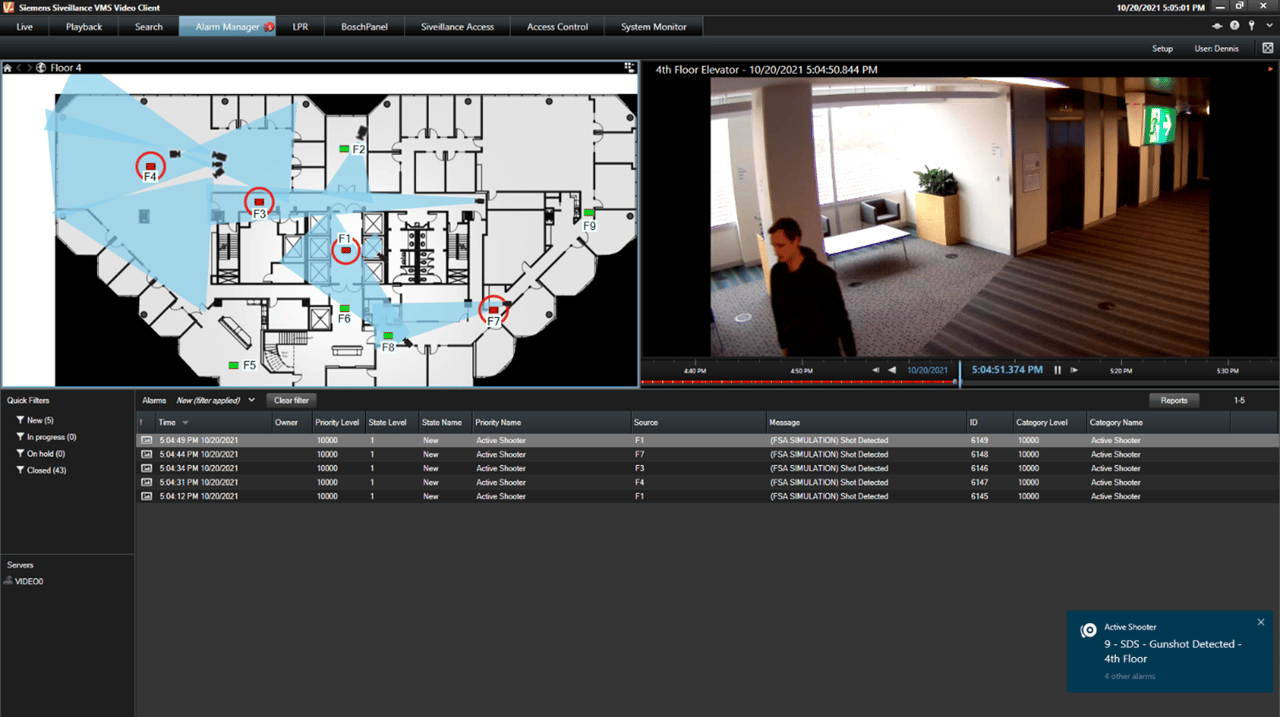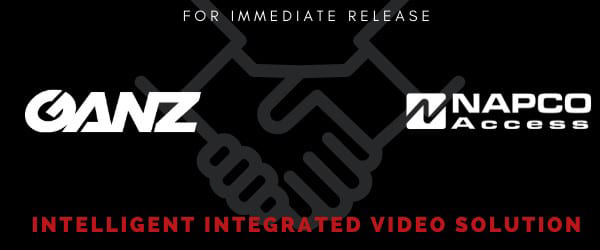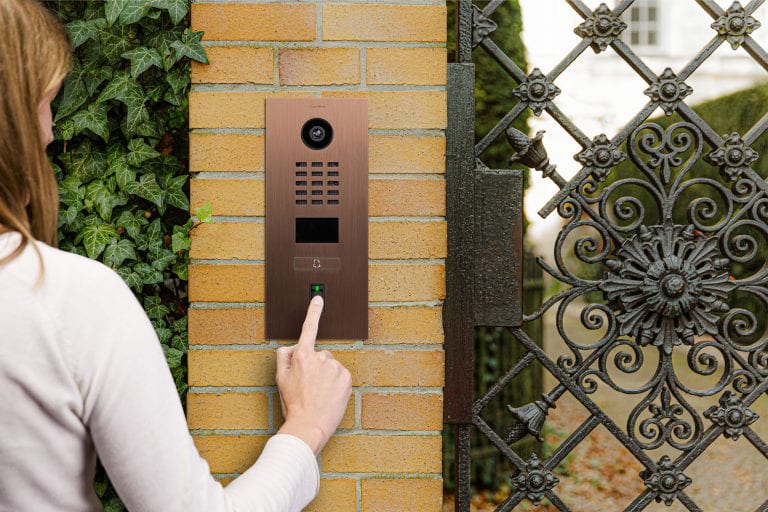TECHNOLOGY
Solutions & Skills
//
Life Safety & Fire Alarm
Siemens, Shooter Detection Systems Integrate Products to Improve Safety During Active Shooter Incidents
Siemens, a technology provider for safe and secure buildings, and gunshot detection provider Shooter Detection Systems (SDS), an Alarm.com company, have integrated technologies to improve public safety in an active shooter situation.
The integration between SDS’s Guardian Indoor Active Shooter Detection System sensors and Siemens’ Siveillance Video management system enables organizations to automatically alert building security by triggering alarms, associate live video feeds with real-time tracking of identified shots on building floor plans, and take other automated actions when gunfire is detected within a building.
“Siemens has been a valued reseller of the Guardian product since 2018,” said Rich Onofrio, managing director of SDS. “By partnering on software integration, we have now amplified the value we bring to mutual customers that are looking for tangible solutions to active shooter notification and response. This integration creates one powerful interface that brings two industry-leading security systems together, working seamlessly to help customers manage gunshot events.”
The SDS Guardian system is a network of smart sensors that utilize advanced acoustic detection software and infrared detectors, immediately and accurately detecting gunshots inside a building while filtering out false alerts. The sensor instantly transmits shot location information, including the building address and the location within the building where shots are fired.
IMAGE COURTESY OF SIEMENS

Siveillance Video is Siemens’ video management system, which provides efficient visual tracking and verification of events. Its modular structure, scalability, and open architecture enable an adaptable approach to an organization’s growing security needs, whether the organization has one or multiple buildings at different locations. Additional systems such as Desigo CC (a building management system) and Cerberus (a danger management system) can be integrated into Siveillance, enabling shooter detection inputs that can trigger automatic responses such as restricted access control and mass notification alerts.
“In the event of a security incident like an active shooter, it’s imperative to know as much information as you can as fast as you can and be able to share those details automatically with first responders,” said Rich Reidy, security segment head at Siemens Smart Infrastructure USA. “Digitalization is the key to creating safer indoor and on-campus environments. The integration of Siemens’ smart security portfolio and SDS’s gunshot detection solution is a prime example of this.”
The combination of these technologies further automates the emergency communications process, expanding the reach of shot notification to more people at once, while automating the video verification process. This removes the obstacles of human reaction time that are commonly associated with delayed notification of gunfire events, ultimately providing security personnel with a means to reduce response time and mitigate risk during active shooter incidents. Additionally, they help create a safer environment for building occupants.
“The Guardian Shooter Detection System signals Siemens security and building automation systems to detect gunfire,” Reidy said. “From there, Siemens security systems can automatically carry out tasks such as aligning camera footage to specific areas; tracking suspects visually; sounding alarms; sending text and email notifications; locking and unlocking doors; and more. These quick actions are imperative to faster response times, saving precious time and potentially lives in critical scenarios by removing delays and avoiding errors during stressful procedures.”
Using the recent school shooting at Oxford High School as an example, such a system could have helped mitigate the harm, Onofrio said. “The Oxford shooting is another tragic example of why SDS exists,” he said. “Most active shootings are perpetrated by someone who already has access to the building, which is where traditional perimeter security and access control systems break down. Gunshot detection is the missing layer of security against insider shooting threats. … Integrating the Guardian Indoor Active Shooter Detection System with other systems automates the part of an active shooter incident that is heavily reliant on the human ear and human reaction in the face of a terrifying event.”
He added that while police had arrived at Oxford within 3 minutes of the more than 100 911 calls made from inside the school, “We don’t know how much time was lost between the first shot and the first 911 calls. This time gap can be addressed with the Guardian System.”
The Siemens/SDS system is a unique product for dealers and integrators to offer customers, especially with the increasing prevalence of gun violence in every segment of society, said Dave McLaren, vice president of sales for SDS. “It’s not such a ‘me too’ product. Just about every integrator has multiple access controls, video management systems, or camera lines. Most dealers don’t carry gunshot detection lines, and if they do, it’s only one. So this is a new revenue stream. ... You name the vertical, and it just comes down to saving the lives of your employees, visitors, and vendors.”
While still only available as part of a customer’s capital expenditure, SDS is weighing the option of offering the Siemens/SDS system as an RMR model in the future, McLaren said.
One option might be to offer customers a subscription for system testing as part of an ASHER (active shooter/hostile event response program) response plan, said Danny Vasquez, national sales manager for security building products for Siemens. Under NFPA standards (3000 and 1600), building owners and operators need to test ASHER systems at least once a year. This requirement could create RMR opportunities for integrators and dealers, he said.
Vasquez is especially excited about the Siemens/SDS system’s proactive approach to a shooter threat. “Typically you have video documentation to go back on, but when you combine two systems, it gives the ability for active management of that situation in real time, which is a big help in reacting to these types of events,” he said.
For more information, visit https://new.siemens.com/global/en/products/buildings/security.html. //
PSIA Approves Secure Credential Specification
The Physical Security Interoperability Alliance (PSIA) has approved the Secure Credential Interoperability (SCI) 1.0 specification. PSIA has been working with a broad group of industry leaders in the access control industry to develop this specification, which is expected to have a significant influence on the future of secure mobile credentials.
Mohammad Soleimani, chief technology officer of Kastle Systems and the chairman of the SCI Work Group, introduced this concept to the organization in 2020 and has had a strong influence in engaging other companies in its development. “A standard for secure mobile credentials has been long overdue in the industry,” he said. “SCI relies on established standards and public key infrastructure (PKI) to provide a simple, but elegant solution.”
SCI addresses the need for a universally compatible secure credential for the physical access control industry in the form of cards, fobs, mobile devices, and wearables. Progress has been dramatic, with the technology being demonstrated at a PSIA technical meeting in August featuring apps from IDEMIA and Johnson Controls and a Kastle reader developed by WaveLynx.

“This is a very important development for us,” said Janusz M. Sochacki, vice president of e.Norman Security Systems, Inc., based in Naperville, Ill., and a member of Security-Net.
Until now, Sochacki has been hesitant to offer his customers mobile credentialing solutions because there has been a lack of standardization on the technology used within systems. “Now that the SCI specification has been established, manufacturers will develop the products that will be compliant with the standard and it will increase the comfort level of customers. If there’s a shortage of one product or a line is no longer offered, there will be another company that will be able to provide a compatible product.”
Laurie Aaron, executive vice president at WaveLynx Technologies Corp., added, “It has been our mission from day one to drive secure credentials and interoperability into the market. Joining PSIA to collaborate and execute on a standard that is made available to all, has been a fast track to mission success.”
One of the important characteristics of SCI is its interoperability across different mobile platforms including iOS and Android or devices with the ability to generate ephemeral key pair, which can be communicated over various protocols such as BLE (Bluetooth Low Energy), NFC, and UWB.
“The SCI specification helps the industry to take steps towards the last mile of credential evolution where interoperability of credentials can exist,” said Jason Ouellette, head of technology and business innovation for Johnson Controls Access Control and Video Solutions business. “The simplicity of the use of a public key leveraging standards and best practices ensure a secure and open way to manage credentials that takes proprietary out of the picture.”
Participants in the spec development include ASSA ABLOY, Deister Electronics, Farpointe Data (a dormakaba company), HID, IDEMIA, Kastle Systems, LenelS2, rf IDEAS, SentryCard, Siemens, and Johnson Controls.
“This is an important milestone in the security industries’ efforts to enable flexible, interoperable and scalable solutions,” said Peter Boriskin, chief technology officer for ASSA ABLOY Opening Solutions Americas. “It will be essential to consider how this and other standards apply across various industries, and how current and emerging standards impact each other.” //
Latch Announces Partner Products With Global Access Leaders
Latch Inc., maker of LatchOS, a full-building enterprise software-as-a-service (SaaS) platform, announced new partnerships with Marks USA, a division of NAPCO Security Technologies, and TownSteel Inc., and an intended partnership with dormakaba Holding AG. The partnerships should bring LatchOS to even more residents, property managers, and guests, and help accelerate growth across new market segments, lock formats, and verticals.
“From the beginning, our vision for Latch has been much broader than access. Our value is in delivering holistic, open solutions that drive user engagement and transform the way people experience the spaces where they live, work, and visit,” said Luke Schoenfelder, Latch co-founder, CEO, and chairman of the board of directors. “As we continue to scale our business, we are excited to bring the power of LatchOS to even more spaces, doors, and people around the world. We are thrilled to partner with these industry leaders to help us accelerate our path forward and meet the rapidly growing market demand for LatchOS.”
The offerings with Marks, TownSteel, and dormakaba are expected to be the first access-based partner offerings in Latch’s growing ecosystem of integrated first- and third-party devices, software, and services.

“We are excited to expand the Marks USA product portfolio and offer new LatchOS-enabled locks to deliver an exceptional, connected access experience for all of our customers,” said Richard Soloway, NAPCO Security Technologies chairman and president. “By combining our industry-leading, quality architectural door access hardware with the power of LatchOS, we can provide a more robust, fluid user experience and enable our customers’ end users to take advantage of the full Latch software suite, from their lobby, to their apartment, to their office, and all the Marks door locks in between.”
Kevin Hamilton, president of TownSteel, added, “At TownSteel, we are looking forward to our new interconnected partnership with Latch. Like Latch, our mission is to never stop thinking of innovative ways to elevate the industry with the most advanced security lock solutions coming to front doors around the world. We are thrilled to be able to expand our product portfolio to offer new LatchOS-enabled locks, delivering an exceptional connected experience for our customers.”
For more information, visit https://www.latch.com/the-latch-lens-partner-program. //
Hakimo Releases AI-Powered Smart Monitoring Software
Hakimo, a venture-backed company dedicated to modernizing physical security, has released its smart monitoring software powered by artificial intelligence (AI) to holistically manage enterprise physical security operations. Hakimo’s software streamlines the workflow of a global security operations center (GSOC) by freeing up time for operators and surfacing security threats, which would have gone unnoticed.
“Hakimo leverages state-of-the-art deep learning technology developed over the last few years,” said Sam Joseph, co-founder and CEO of Hakimo. “What Hakimo is doing today was literally impossible to achieve just a decade ago. Hakimo-like tools have been the norm in the cybersecurity industry and Hakimo is pioneering the convergence between cybersecurity and physical security by bringing them to physical security.”
Tailgating, when an unauthorized person follows an authorized individual into secured premises, is a serious concern for every security organization. Hakimo’s software detects tailgating using existing cameras without needing any additional hardware to be deployed. The software also includes gamification tools and automated email alerts to bring about behavior change in employees. Corporate security systems using Hakimo’s software reported a 99 percent precision rate on hundreds of thousands of events analyzed by the system, according to the company.
Hakimo also uses video analytics to auto-resolve false alarms and consistently reduces nuisance alarms by 75 percent to 85 percent, allowing GSOC operators to focus on real issues that require true human attention and handle five times the volume of alarms with the same amount of resources.
Joseph

Hakimo was founded by AI researchers at Stanford University and raised a $4 million seed round from several top Silicon Valley investors. The round was led by Neotribe Ventures and saw participation from defy.vc, Firebolt Ventures, and angel investors such as Ameet Patel, Prasanna Srikhanta, and Stanford professor Sachin Katti. Hakimo’s solution is currently deployed at several leading enterprises across the country.
For more information, visit www.hakimo.ai. //

CBC AMERICA, a manufacturer of intelligent security systems and the parent company of Ganz, announced a strategic business alliance with Napco Security Technologies Inc., a provider and manufacturer of technologically advanced electronic security equipment including intrusion and fire alarm systems, communications, and enterprise-class access control and door-locking products. This collaboration will deliver an intelligent video solution with the integration of Ganz CORTROL video management software with Napco access solutions and the Continental access control platform.
Ganz CORTROL VMS offers two-way integration and provides a unified interface between NAPCO access and security systems running within the Continental access control platform. This union optimizes the end user’s control of the system and allows proactive scenarios to operate system-wide.
For more information go to ganzsecurity.com.
IMAGE COURTESY OF NAPCO

Brivo, a provider of cloud-based access control and smart building technologies, announced the release of Anomaly Detection in its flagship access control solution, Brivo Access. Anomaly Detection is now available in the Enterprise Edition of Brivo Access.
Anomaly Detection is a patent-pending technology that uses advanced analytics with machine learning algorithms to compare massive amounts of user and event data to identify events that are out of the ordinary or look suspicious, and issues priority alerts for immediate follow up. Anomaly Detection’s AI engine learns the unique behavioral patterns of each person in each property they use to develop a signature user and spatial profile, which is continuously refined as behaviors evolve. This dynamic real-time picture of normal activity complements static security protocols, permissions, and schedules. In practice, when someone engages in activity that is a departure from their past behavior, Anomaly Detection creates a priority alert in Brivo Access Event Tracker indicating the severity of the aberration. This programmed protocol helps organizations prioritize what to investigate.
For more information, visit www.Brivo.com.

Speco Technologies, a provider of video surveillance equipment, has integrated its SecureGuard servers and recorders with its I-View Now platform. SecureGuard is a video management solution for monitoring video, audio, and access control from Speco Technologies products.
Integrating with the I-View Now platform now enables Speco Technologies’ customers to securely monitor properties efficiently and remotely. Combining the SecureGuard interface with I-View Now helps users reduce false alarms and verify alarms during the dispatch process.
To learn more about SecureGuard and its integration with I-View Now, go to www.specotech.com.

Bird Home Automation, a Berlin-based manufacturer of DoorBird IP access control devices, is expanding its product portfolio to include door intercoms with an integrated sensor module from Fingerprint Cards AB in its D21 series.
With a DoorBird door station, homeowners and residents can see and speak to visitors via their smartphones and manage access by unlocking the door when needed. Each door intercom features an HD wide-angle camera, motion sensor, and audio system with echo and noise cancellation. Existing keyless access control options via RFID or PIN code is expanded with biometrics by fingerprint. The fingerprint module is fully integrated into the DoorBird software architecture and can be configured remotely, via app or web-based dashboard, at any time to grant and withdraw access permissions.
To learn more, visit https://www.doorbird.com/en/.
IMAGE COURTESY OF DOORBIRD

The New DICE Corporation has integrated Calipsa’s false alarm filtering solution with Matrix Interactive. The integration provides central stations and integrators that are already using Calipsa’s solution with the option to add advanced interactive and video services from Matrix Interactive. It will also allow DICE users to benefit from Calipsa’s leading AI technology.
Calipsa’s analytics software for video surveillance uses deep learning algorithms to filter out false alarms caused by anything from a change in lighting to a spider’s web across a lens, with a false alarm reduction rate of 95 percent. Matrix Interactive offers central stations and command centers a video event monitoring, surveillance, and alarm notification suite for any video system that is accessible from any location, at any time. The unified platform provides services such as video verification, remote guarding, virtual guard tours, and virtual door attendant — all using advanced video analytics, artificial intelligence, and cloud recording of events.
For more information, visit https://dicecorp.com/.

March Networks, an Ontario-based video and data integrator, has achieved CyberSecure Canada certification, developed by the Canadian Centre for Cyber Security, Canada’s authority on cybersecurity.
Certified organizations must put into place the requirements of the 13 security control areas developed by the Centre. Examples include developing an incident response plan, implementing strong user authentication, providing employee training, implementing data recovery methods, and ensuring encryption across all data. After implementing the requirements, an organization must be audited by an accredited certification body.
For more information, visit marchnetworks.com.
IMAGE COURTESY OF MARCH NETWORKS

